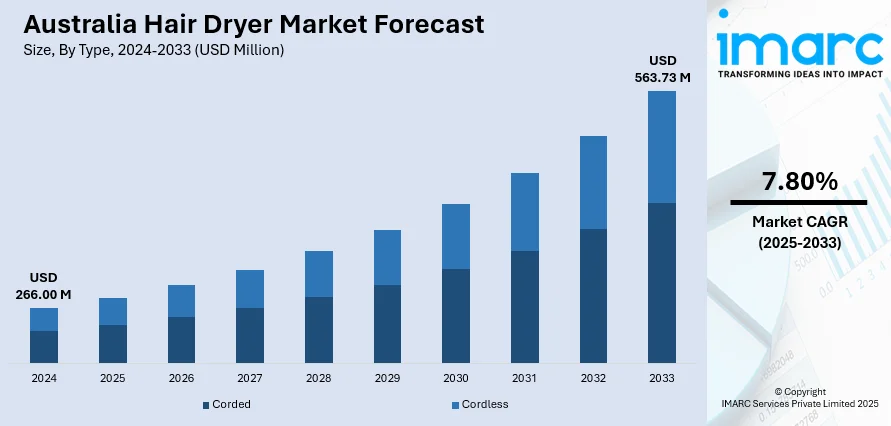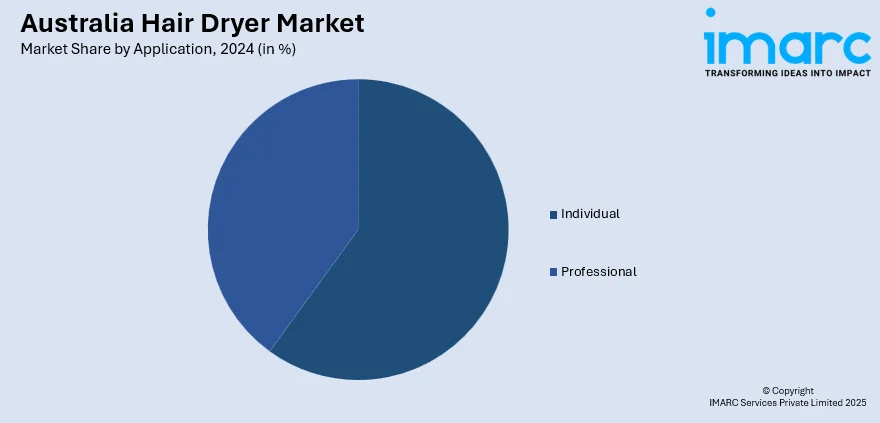
Australia Hair Dryer Market Size, Share, Trends and Forecast by Type, Application, Distribution Channel, and Region, 2025-2033
Australia Hair Dryer Market Overview:
The Australia hair dryer market size reached USD 266.00 Million in 2024. Looking forward, IMARC Group expects the market to reach USD 563.73 Million by 2033, exhibiting a growth rate (CAGR) of 7.80% during 2025-2033. The market is driven by increasing consumer preference for sustainable hair dryers, supported by energy-efficient technologies, as well as government initiatives promoting eco-friendly appliances. Rising disposable incomes and demand for premium smart dryers, featuring AI temperature control and Bluetooth connectivity, stimulate growth. Social media influence and changing beauty standards continue to elevate expectations, further augmenting the Australia hair dryer market share.
|
Report Attribute
|
Key Statistics
|
|---|---|
|
Base Year
|
2024
|
|
Forecast Years
|
2025-2033
|
|
Historical Years
|
2019-2024
|
| Market Size in 2024 | USD 266.00 Million |
| Market Forecast in 2033 | USD 563.73 Million |
| Market Growth Rate 2025-2033 | 7.80% |
Australia Hair Dryer Market Trends:
Rising Demand for Sustainable and Energy-Efficient Hair Dryers
The market is experiencing a growing demand for sustainable and energy-efficient products, driven by increasing consumer awareness of environmental concerns. An industry report revealed that 75% of Australians expect brands to take a stand on sustainability. Along with this, more than 40% of online shoppers search for ethical and green products. Over three-quarters of shoppers prefer locally sourced goods, and 47% show greater loyalty toward brands with sustainable return policies. Following data trends makes it a significant opportunity for hair dryers in Australia to personally align their solution with the sustainable brand trend in a growing consumer base. Consumers are actively seeking hair dryers with features such as low energy consumption, reduced carbon footprints, and eco-friendly materials. Brands are responding by incorporating advanced technologies including ionic and ceramic heating elements, which dry hair faster and consume less power. Additionally, companies are introducing recyclable packaging and durable designs to minimize waste. Government initiatives promoting energy efficiency, such as the Energy Rating Label program, further encourage buyers to opt for high-performance, eco-conscious models. This trend aligns with the broader shift toward sustainable beauty and personal care products in Australia, making energy-efficient hair dryers a key growth segment in the market.

To get more information on this market, Request Sample
Growth in Premium and Smart Hair Dryers with Advanced Features
The rising popularity of premium and smart hair dryers equipped with advanced technologies is supporting the Australia hair dryer market growth. Consumers are increasingly willing to invest in high-end models that offer features including AI temperature control, Bluetooth connectivity, and customizable heat settings for personalized styling. Brands are leading this segment with innovative designs that minimize heat damage while optimizing drying efficiency. The influence of social media and celebrity endorsements has also fueled demand for salon-quality devices at home. Furthermore, the expansion of e-commerce platforms has made premium hair dryers more accessible, allowing consumers to compare features and read reviews before purchasing. The Australian e-commerce industry reached a record high of AUD 63.6 Billion (approximately USD 40.98 Billion) in 2024, with fashion and electronics leading the way in sales. Online spending accounts for 16.8% of total expenditure, representing a 68% increase from pre-pandemic levels. With Australian industries, such as the gear oil business, embracing digital platforms more than ever before, these figures confirm the growing role of e-commerce in driving business change and enhancing consumer interaction. As disposable incomes rise and beauty routines become more sophisticated, the premium segment is expected to grow steadily.
Australia Hair Dryer Market Segmentation:
IMARC Group provides an analysis of the key trends in each segment of the market, along with forecasts at the country and regional levels for 2025-2033. Our report has categorized the market based on type, application, and distribution channel.
Type Insights:
- Corded
- Cordless
The report has provided a detailed breakup and analysis of the market based on the type. This includes corded and cordless.
Application Insights:

- Individual
- Professional
A detailed breakup and analysis of the market based on the application have also been provided in the report. This includes individual and professional.
Distribution Channel Insights:
- Online
- Offline
The report has provided a detailed breakup and analysis of the market based on the distribution channel. This includes online and offline.
Regional Insights:
- Australia Capital Territory & New South Wales
- Victoria & Tasmania
- Queensland
- Northern Territory & Southern Australia
- Western Australia
The report has also provided a comprehensive analysis of all the major regional markets, which include Australia Capital Territory & New South Wales, Victoria & Tasmania, Queensland, Northern Territory & Southern Australia, and Western Australia.
Competitive Landscape:
The market research report has also provided a comprehensive analysis of the competitive landscape. Competitive analysis such as market structure, key player positioning, top winning strategies, competitive dashboard, and company evaluation quadrant has been covered in the report. Also, detailed profiles of all major companies have been provided.
Australia Hair Dryer Market News:
- May 02, 2025: Dyson unveiled its new Supersonic hair dryer at an exclusive event in Sydney, showcasing the professional-quality machine available for Australian consumers for AUD 799 (approximately USD 514.32). Twenty-one top beauty influencers attended the launch event, and social media hype is already enhancing the product's popularity. Available in rare colors of Jasper Plum and Ceramic Pink, the Supersonic r™ marks a new era in home hair care technology.
Australia Hair Dryer Market Report Coverage:
| Report Features | Details |
|---|---|
| Base Year of the Analysis | 2024 |
| Historical Period | 2019-2024 |
| Forecast Period | 2025-2033 |
| Units | Million USD |
| Scope of the Report |
Exploration of Historical Trends and Market Outlook, Industry Catalysts and Challenges, Segment-Wise Historical and Future Market Assessment:
|
| Types Covered | Corded, Cordless |
| Applications Covered | Individual, Professional |
| Distribution Channels Covered | Online, Offline |
| Regions Covered | Australia Capital Territory & New South Wales, Victoria & Tasmania, Queensland, Northern Territory & Southern Australia, Western Australia |
| Customization Scope | 10% Free Customization |
| Post-Sale Analyst Support | 10-12 Weeks |
| Delivery Format | PDF and Excel through Email (We can also provide the editable version of the report in PPT/Word format on special request) |
Key Questions Answered in This Report:
- How has the Australia hair dryer market performed so far and how will it perform in the coming years?
- What is the breakup of the Australia hair dryer market on the basis of type?
- What is the breakup of the Australia hair dryer market on the basis of application?
- What is the breakup of the Australia hair dryer market on the basis of distribution channel?
- What is the breakup of the Australia hair dryer market on the basis of region?
- What are the various stages in the value chain of the Australia hair dryer market?
- What are the key driving factors and challenges in the Australia hair dryer market?
- What is the structure of the Australia hair dryer market and who are the key players?
- What is the degree of competition in the Australia hair dryer market?
Key Benefits for Stakeholders:
- IMARC’s industry report offers a comprehensive quantitative analysis of various market segments, historical and current market trends, market forecasts, and dynamics of the Australia hair dryer market from 2019-2033.
- The research report provides the latest information on the market drivers, challenges, and opportunities in the Australia hair dryer market.
- Porter's five forces analysis assist stakeholders in assessing the impact of new entrants, competitive rivalry, supplier power, buyer power, and the threat of substitution. It helps stakeholders to analyze the level of competition within the Australia hair dryer industry and its attractiveness.
- Competitive landscape allows stakeholders to understand their competitive environment and provides an insight into the current positions of key players in the market.
Need more help?
- Speak to our experienced analysts for insights on the current market scenarios.
- Include additional segments and countries to customize the report as per your requirement.
- Gain an unparalleled competitive advantage in your domain by understanding how to utilize the report and positively impacting your operations and revenue.
- For further assistance, please connect with our analysts.
 Request Customization
Request Customization
 Speak to an Analyst
Speak to an Analyst
 Request Brochure
Request Brochure
 Inquire Before Buying
Inquire Before Buying




.webp)




.webp)












